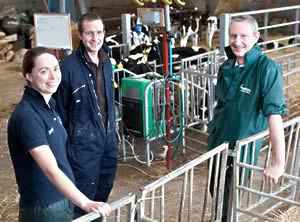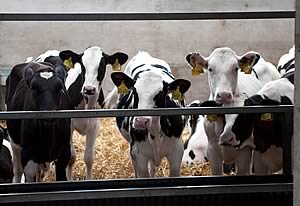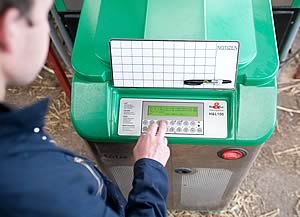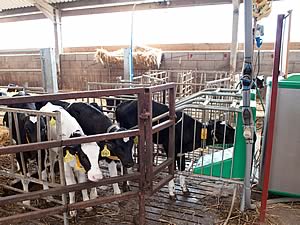 |
|||||||||
|
||||||||||||||||||||
|
|
An Holistic Approach to Calf Pneumonia Control Calf health has been dramatically improved at Dobcross Hall Farm following an holistic approach to pneumonia control.
Peter and Alison Holliday and sons Ian and Alistair farm 410 acres, mostly rented from the Church Commissioners, where they run the closed Holdale pedigree Holstein herd which averages 9,600 litres a cow with milk sold to Meadow Foods. 100 acres of winter and spring barley and winter wheat is grown and whole-cropped and crimped. Paragon Veterinary Group’s David Black, as part of his routine fortnightly visits to the farm at Gaitsgill, Carlisle, has regular discussions with the Hollidays about general herd health which was already running at a high level. However, over the past one to two years young calves have had issues with coughing and pneumonia as well as the occasional joint problem and ear infection, resulting in growth rate setback and the odd calf death, vet Jemma Reed from XLVet’s member practice Paragon encouraged the Hollidays to take advantage of the RDPE Northwest Livestock Programme Animal Health and Welfare Project. The programme subsidised the cost of testing so calves were blood sampled to investigate the cause of the problem and tests pinpointed Mycoplasma as the cause. Previously, the calves were receiving multiple treatments, and Jemma chose a specific antibiotic (Draxxin) to tackle the bacteria, which is unusual in that it doesn’t have a cell wall, as well as an anti-inflammatory (Metacam). “There is no vaccination for this particular bug as a preventative measure so key to controlling it is management,” said Jemma. “It can be present in the cows’ milk but it can also spread from calf to calf. So we looked at the wider picture. “Pneumonia costs the UK cattle industry around £80 million a year, with the average cost per ill dairy calf running at £43 which takes into account weight loss or poor daily liveweight gain which is the biggest single cost, vet fees, death and increased labour,” she added. “Addressing the major risk factors such as ventilation, housing and stocking and vaccination based on the farms history, clinical signs and diagnostic tests is the way to help prevent pneumonia’.
Symptoms of pneumonia include increased breathing rate and effort, a cough, nasal discharge, a raised temperature with calves being off their feed and apparently dull. Treatment is with antibiotics and anti-inflammatories. First to be looked at at Dobcross Hall was the level of maternal antibodies received through colostrum by calves in their first week of life. “We thought our colostral transfer level was fine - the calves were getting six pints of their mother’s colostrum in six hours,” said Ian. “However, we learned that they should receive seven per cent of their body weight within six hours of birth and 10 per cent in 12 hours. “For the calf to get the volume needed, it would have to suckle for 20 minutes. We started tubing the calves twice within the first six to 12 hours to give them the required amount of colostrum,” he added. Subsequent tests showed that the new system was providing good levels of maternal transfer of antibodies.
The Hollidays also discussed the method of rearing the calves and decided to change from bucket rearing to a two station calf feeding machine in March (2010). "By allowing controlled but regular access to milk replacer, calf machines are a much more natural method of feeding, but producers must pay real attention to both hygiene and management and the result will be much better growth rates," said Jemma. Now calves drink up to a maximum of 7.2 litres a day compared with the 4.5 litres on the bucket system with activity monitored by the machine’s computer. Improvements in overall health have been significant say the Hollidays and this should help them in their aim to calve heifers at two years old or younger. By being ultra hygienic and cleaning the machine twice a day, intakes have been increased by a further 10 per cent. While the time spent filling and cleaning the machine is similar to the old bucket rearing method, it can more easily fit in with other work on the farm throughout the day. Calves are gradually and automatically weaned off the machine within 60 days. Also new to the calf management is maintaining the same animals in groups of up to 10, even after weaning, to help reduce stressful social changes.
A new extension has been built onto the existing calf shed at a cost of £12,000 to house the weaned calves for up to two months prior to turning out. Previously after weaning they were turned into the same building as older youngstock. Further investments of £6,000 were made, with grant aid, in improving ventilation to the original and new building extension with an Arntjen curtain system, replacing Yorkshire boarding. It is operated with separate weather stations on either side of the building to control air flow above the calves. “With the help of our vets we are continually trying to improve all areas of performance within the herd,” said Peter. “It costs well over £1,000 to get a heifer to calving which we are currently averaging at 25 months. As a result of the changes made, we are spending less; our antibiotic usage alone has reduced by half, and we are getting a healthier animal which we may be able to calve even earlier and also should have a more productive lifetime,” he added.
AVOIDING CALF PNEUMONIA
|
|||||||||||||||||||

|
|
|||||||||||||||||||
| home | agri-services | pedigree
pen | news | dairy | beef | machinery property | organisations | site map |
||||||||||||||||||||

Article by
Jennifer MacKenzie



